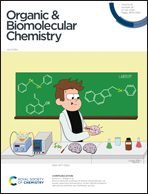A synthetic guide to alkynyl sulfides
Abstract
The relative stability and predictable reactivity of alkynyl sulfides make them ideal synthons for the development of new transformations. Classic methods for forming alkynyl sulfides relied on dehydrohalogenation approaches. However more recent methods have focused on employing umpolung strategies, as well as nucleophilic and electrophilic thiol alkynylation. In addition, the recent syntheses of Csp–S bonds have trended towards exploiting catalysis and expanding the reaction scope of the methods. A survey of existing methods to form alkynyl sulfides is presented as well as an evaluation with regards to the scope of each method, to provide the reader with an overview of advantages and limitations of current technology.



 Please wait while we load your content...
Please wait while we load your content...